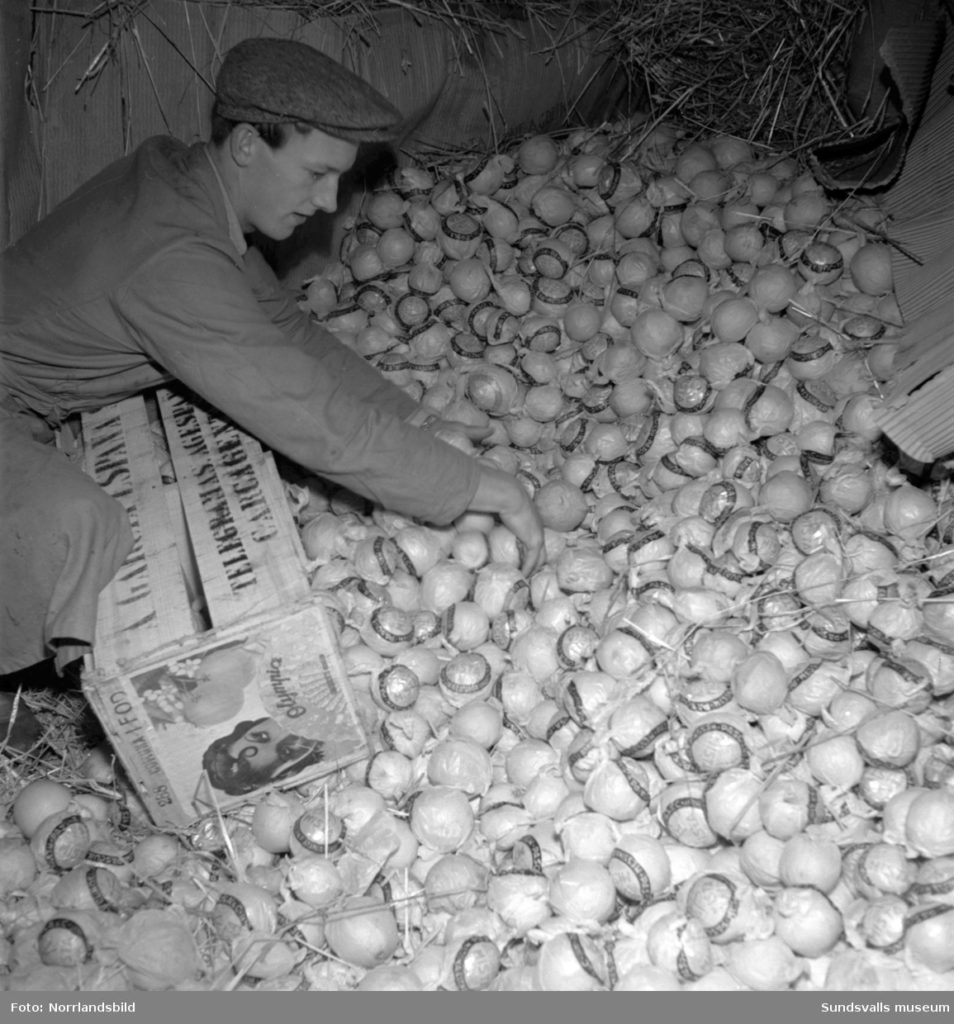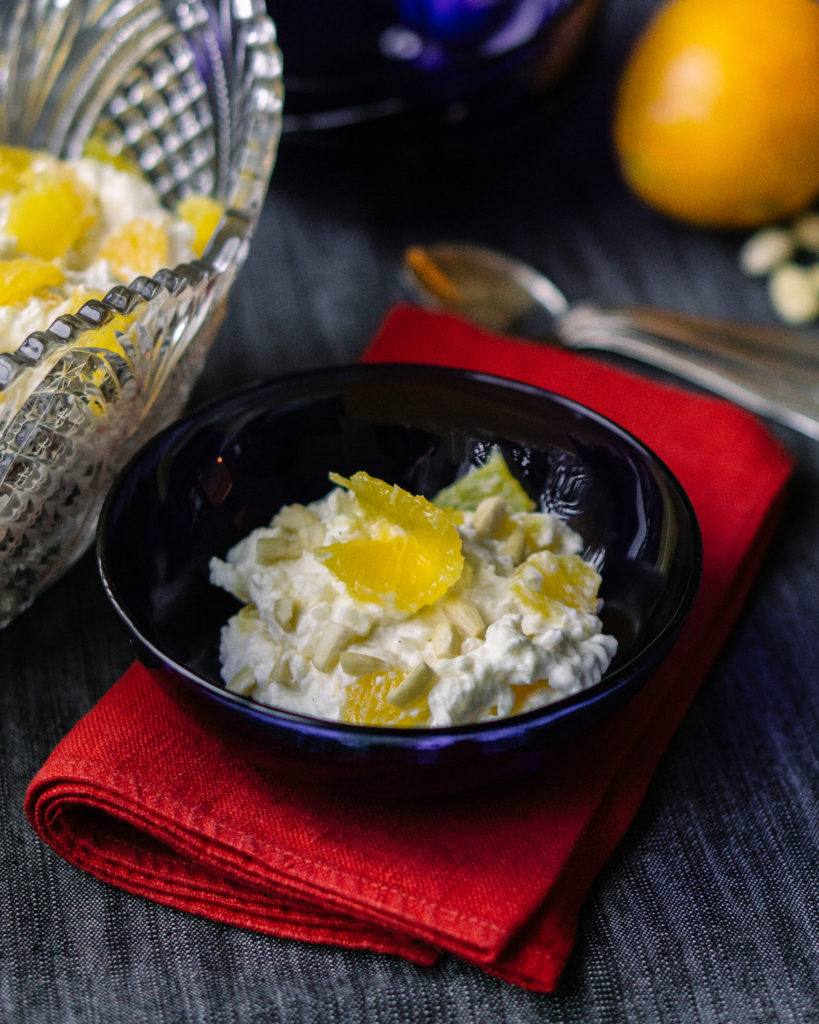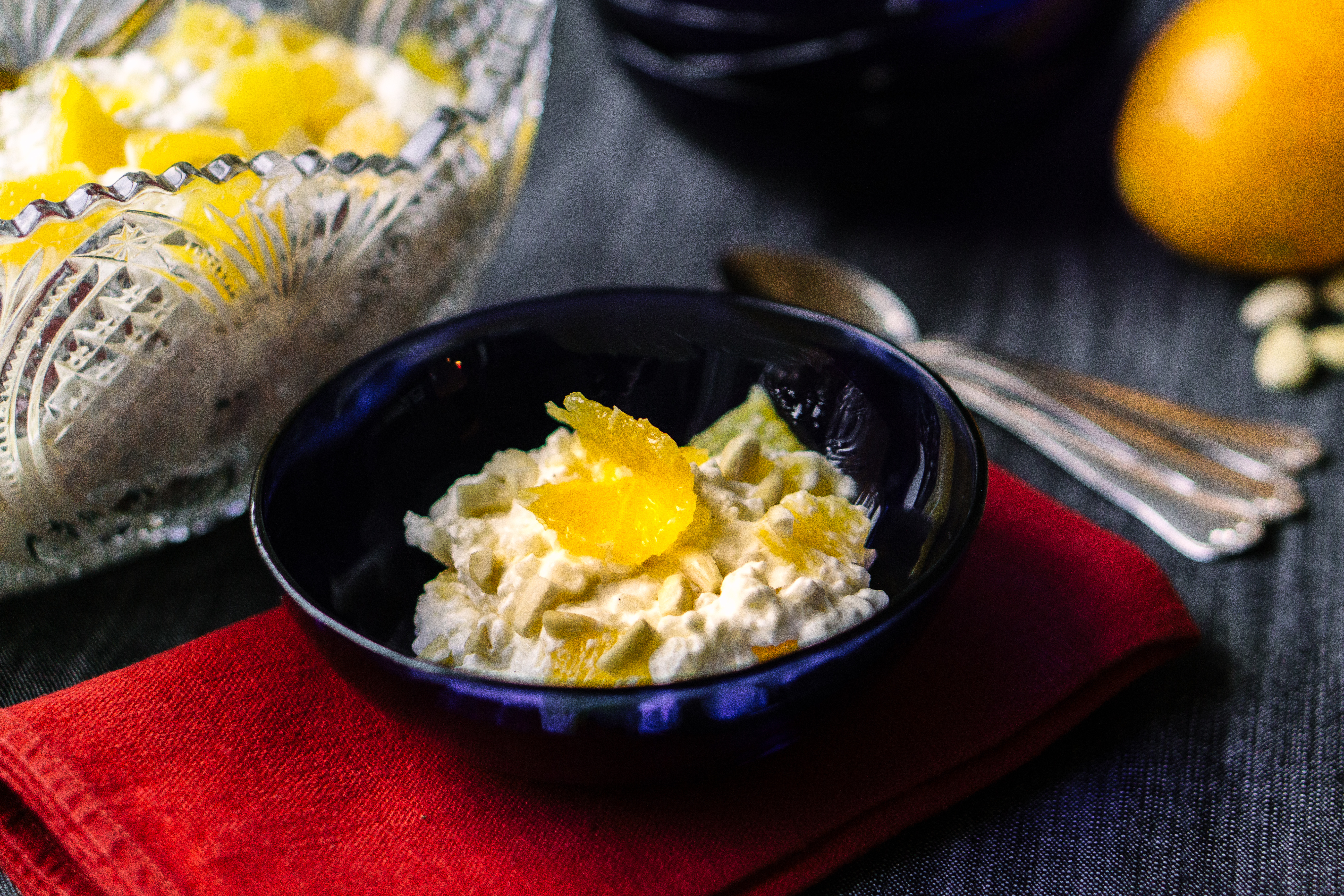Ris à la Malta turns out to be another dish with an “either this, either that”-origin.
But before we get into that, the fact is that this dish conveniently solves a potential dilemma. If you’re making copious amounts of rice porridge for Christmas, you might have leftovers. Then, you’ll need to turn to this dish. While you’re at it, you can use the juicy oranges that are coming into season.
The history of Ris à la Malta
While this dish is most strongly connected to Christmas nowadays, Jan-Öjvind Swahn calls ris à la Malta a “classic Sunday dessert” in Mathistorisk uppslagsbok. He connects the name to the Mediterranean island of Malta, known for its oranges. Checking with Larousse Gastronomique, the term à la Maltaise describes “sweet or savoury preparations which are based on oranges, particularly the Maltese blood orange”. It seems that it would be a dish with oranges.
Swahn claims that the dessert’s first appearance under this name in Sweden is in Hagdahl’s 1879 cookbook (I only have the 1896 version, but the recipe is likely the same). Hagdahl’s Kok-konsten features “Risgryn med apelsin—Riz à la Malte”, where sugar, oranges, orange peel, lemons, wine, and carmine are used to make a sauce into which you stir in the rice porridge. After the mixture has cooled in little bowls, you plate it and serve with orange slices and an orange sauce.
Hagdahl’s recipe is similar to Gustafwa Björklund’s from 1847 with its elaborate dessert called Ris-Pudding med frukt, where the flavored rice is layered with boiled apples and crumbled biscuits and—of course—served in a bowl of crystal.
But—Magnus Nilsson notes that the Danish upper class started serving sweetened rice porridge mixed with cream around the beginning of the 1900s. Risalamande, the Danish name for the dish, comes from the French riz à l’amande, meaning “rice with almonds”. Nilsson claims that the Swedes misspelled the Danish name and dropped the almonds.
So, is it Malta because of Maltese oranges, or because of sloppy spelling? I tend to believe more in the oranges, but the rice pudding exists both served with rice and with red jam.

What’s in ris à la Malta?
This type of rice-based dessert has been popular for a long time, so there are many variations. For example, in Iduns hjälpreda from 1893, there’s a recipe for riskräm (“rice cream”) flavored with lemon juice and rum and layered with raspberry jam.
In Husmoderns kokbok from 1927, Kerstin Wenström features a Ris à la Malta—by that name—which contains gelatine. The idea is to be able to turn the dish upside down on a plate before serving. This beauty is flavored with vanilla or lemon peel, but no oranges, and is served with fruit sauce or jam.
The recipe for apelsinris in Prinsessornas kokbok from 1934 prepares a sweetened rice porridge with orange pieces and a bowl of whipped cream separately, only mixing them together before serving.
The little dilemma with the dessert’s origin doesn’t seem to bother Magnus Nilsson, who solves it by featuring two recipes. He makes his ris à la Malta with only rice porridge, cream, and sugar, and notes that it often is served with fruit sauce or a berry compote. Then he has another recipe for apelsinris, “rice with orange”, which is flavored with sugar, vanilla sugar, oranges, orange peel, and toasted almond flakes.
To summarize, the typical recipe of today consists of rice porridge, cream, and sugar. Then there’s either oranges, jam, or fruit sauce.

How to make ris à la Malta
This recipe is enough for four people, depending on how much Christmas food you ate before.
Base
5 dl (2 cups) leftover rice porridge
2 dl (0,8 cups) cream
1-2 tbsp icing sugar
1 small pinch vanilla powder
Flavor
2-3 oranges, or red jam (raspberry, cherry, etc)
Garnish: optional chopped almond or almond flakes, if you’re feeling fancy
- If you don’t have any leftover rice porridge, bring 1,5 dl (0,6 cups) short-grain rice to a boil with 3 dl (1,4 cups) water. Let it simmer for 10 minutes. Add 6 dl (2,8 cups) milk, bring it to a boil, and then cook at a low temperature for about 20-30 minutes or until the milk is absorbed. Stir occasionally to prevent burning. Let it cool before continuing.
- Whip the cream until it is thick and fluffy. Stir in the icing sugar and vanilla powder.
- Add the cold rice porridge to the cream bowl. Stir until it is blended.
- Remove the oranges’ outer skin, piths, and then skins casing the oranges’ sections. Chop the sections into pieces, keeping the juice, and stir pieces and juice into the rice cream. Garnish with extra orange pieces or almonds on top, if you like. Alternatively, serve with a flavorful jam.
Suggestions
Serve this dish however you like, depending on what fruits and berries you like and what is in season.
If you want to serve it with a fruit sauce, heat up 3 dl (1,2 cups) cordial, such as cherry, raspberry, or a mix of fruits and berries. Stir a tablespoon of potato starch into a little bit of water. Remove the cordial form the heat and stir in the starch water. Serve.



There seems to be something wrong with the following text above:
“Swahn claims that the dessert’s first appearance under this name in Sweden is in Hagdahl’s 1879 cookbook (I only have the 1896 version, but the recipe is likely the same). Hagdahl’s Kok-konsten features “Risgryn med apelsin—Riz à la Malte”, where sugar, oranges, orange peel, lemons, wine, and carmine are used to make a sauce into which you stir in the rice porridge.”
The Hagdahl recipe (in the 1896 edition) does not involve any rice porridge at all: it is only rice cooked in white wine with some orange juice, orange zest and sugar (and some red food colouring stuff). No milk for boiling, and no cream for added body — both of which are almost mandatory in modern recipes. Thus, Hagdahl’s recipe is for a rather different dish, which seems to share fairly little with the modern one, except for the rice and the oranges … and the name.
Hi Anders,
Thank you for your interesting comment! I had to return to Hagdahl now… Yes, I agree that Hagdahl’s dish is very different than what we today think of as Ris à la Malta. His dish sounds fancier–you can cut it into shapes, rather than the modern dish which is delightful but somewhat sloppy. Maybe whipped cream is more of a 20th century addition?
What I find interesting is that his Malta-dish features oranges. Some modern recipes, such as Magnus Nilssons, consider ris à la Malta to be connected to almonds rather than oranges. So, some support for oranges instead. What do you think?
There’s a wealth of curious rice pudding dishes in Hagdahl’s book. Maybe I’ll try to cook a “turban de pommes au riz”, risgrynsturban, up next…